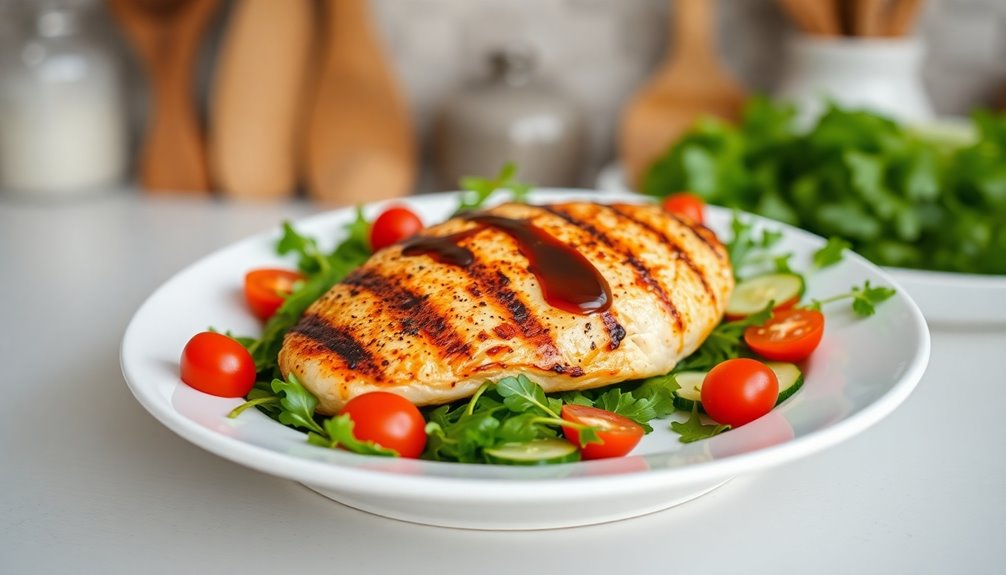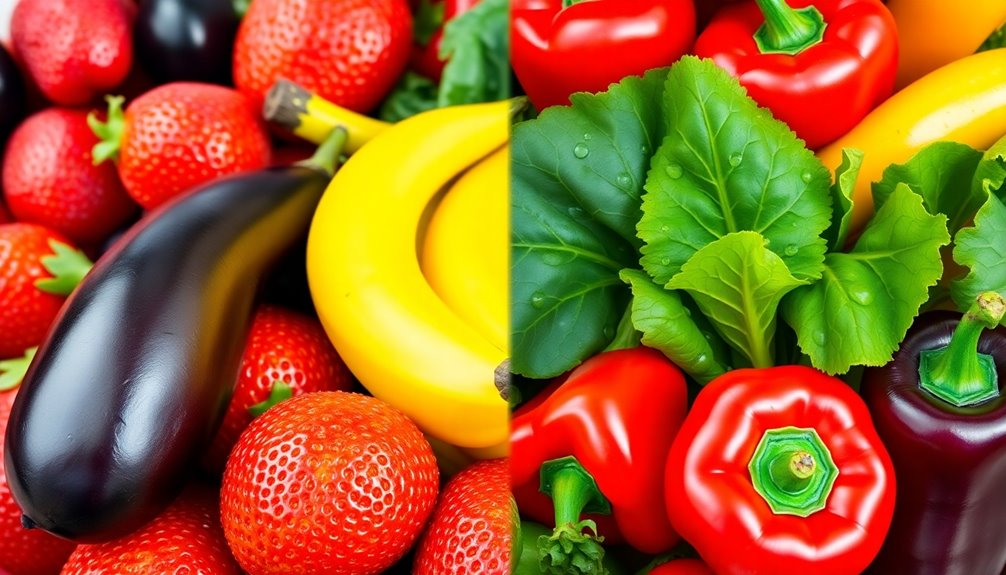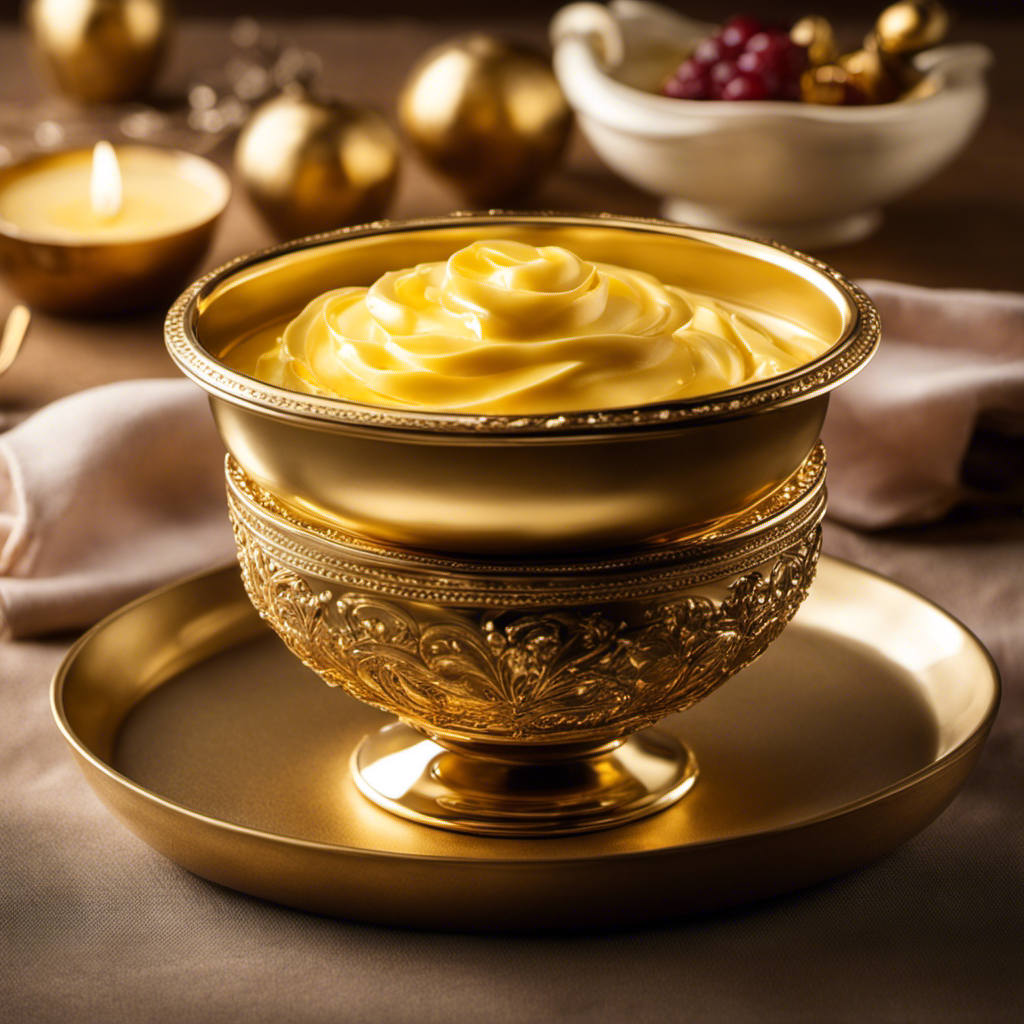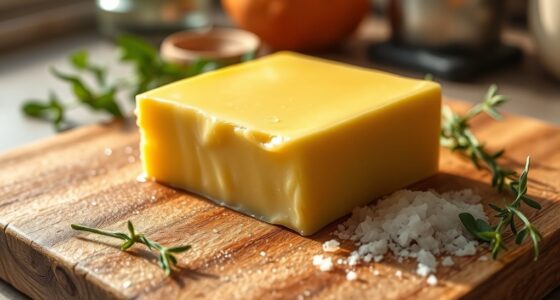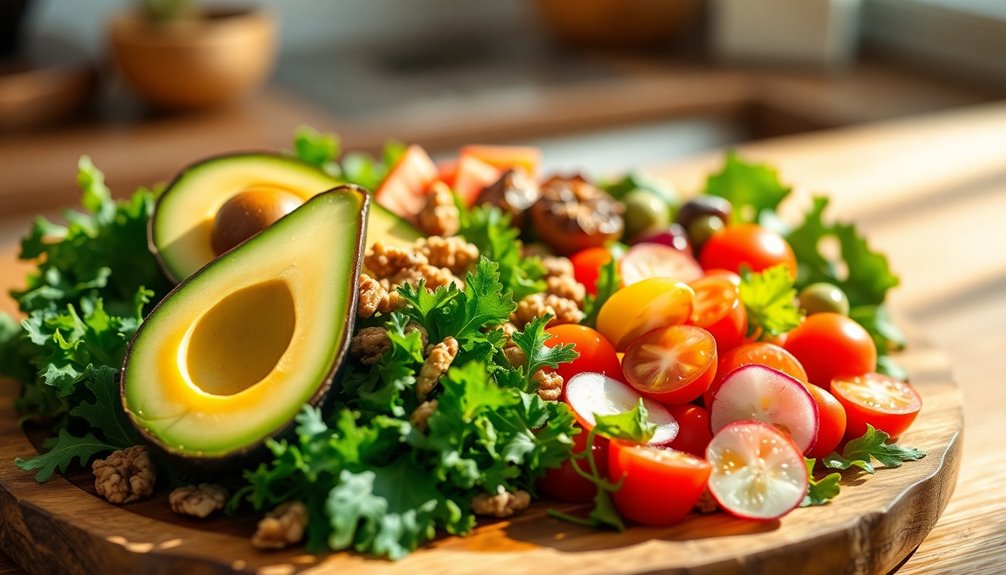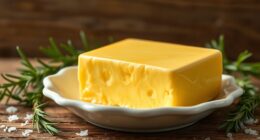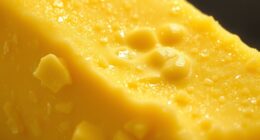When visualizing 6 ounces of protein, think of it as two cooked chicken breasts, which is about the size of two decks of cards. If it's nuts, you're looking at a medium-sized bowl filled to about 6 servings, while a serving of canned beans would be roughly 1 ¼ cups cooked. For nut butter, imagine around 12 tablespoons, about 1 ½ heaping dinner spoons. Finally, a serving of Greek yogurt is a manageable 6 ounces, providing significant protein. There's more to uncover about protein sources and their benefits, so stick around for additional insights!
Key Takeaways
- Meat serving: 6 ounces of cooked meat equals 2 servings, resembling 2 decks of cards or a medium chicken breast.
- Beans portion: 6 ounces of cooked beans is about 1 1/4 cups, comparable to a large clenched fist.
- Nut butter measurement: 6 ounces equals 12 tablespoons, visualized as a medium grapefruit or a standard coffee mug.
- Nuts equivalent: 6 ounces of nuts amounts to roughly six standard servings, fitting in a medium-sized bowl.
- Yogurt serving: 6 ounces of Greek yogurt is manageable, providing around 17.25 grams of protein per serving.
Understanding Protein Serving Sizes
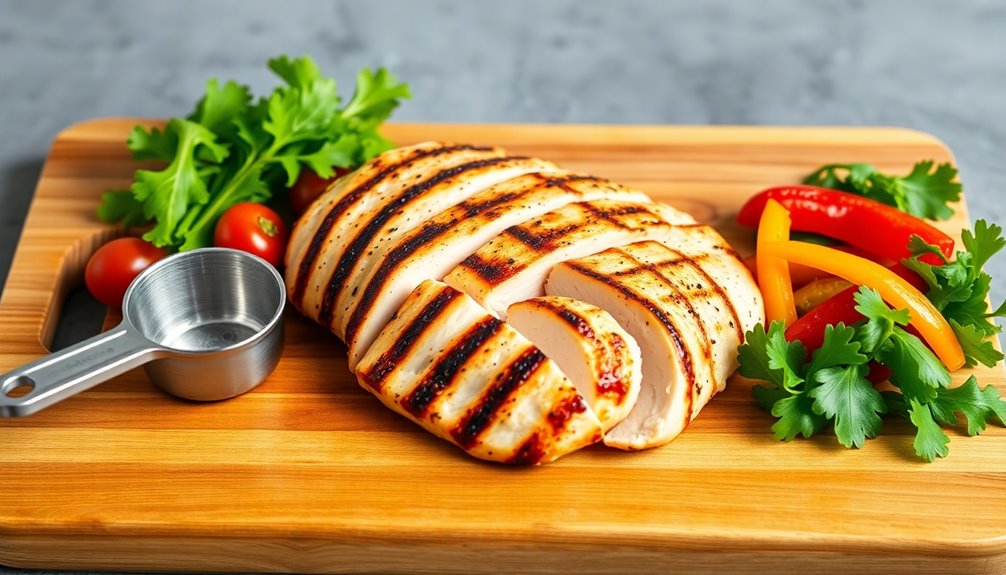
When it comes to understanding protein serving sizes, it's essential to visualize what a typical portion looks like. For many protein sources, a standard serving size for meat is about 3 ounces, roughly the size of a deck of playing cards or your palm. This visual cue can help you meet your protein needs effectively.
When you're considering fish or seafood, aim for a serving size around 3 to 4 ounces, which you can imagine as a tennis ball or a checkbook.
Beans, legumes, and grains typically come in 1/2 cup cooked portions, which can be visualized as the size of a clenched fist.
For nuts and seeds, the standard serving size is 1 ounce, which might include around 23 almonds or 7 walnuts. If you're using nut butters, remember that 2 tablespoons is about the size of a heaping dinner spoon.
Keeping these visual cues in mind can greatly aid in understanding protein serving sizes and help you meet your daily recommended intake more accurately. By doing so, you'll guarantee you're fueling your body with the right amount of protein.
Visualizing 6 Ounces of Meat
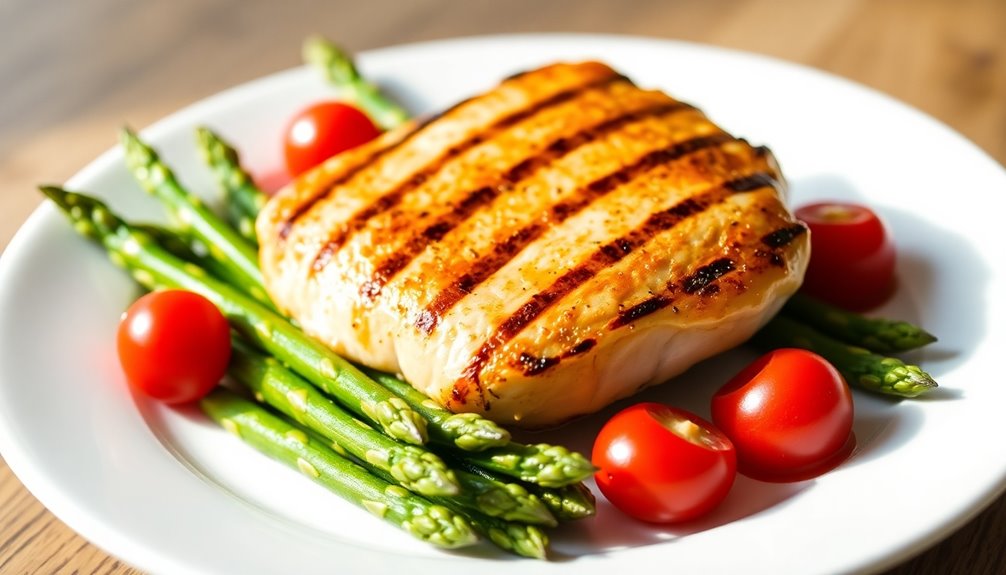
Visualizing 6 ounces of meat becomes easier once you grasp the standard serving sizes. Typically, a standard serving size of cooked meat is 3 ounces, so 6 ounces would equal two servings. For a visual reference, imagine two decks of playing cards stacked together; that's about the size you're looking for.
When it comes to common protein sources, 6 ounces of cooked chicken breast is roughly the size of a medium-sized breast, packing around 52 grams of protein.
If you're considering shrimp, picture 12-16 medium-sized shrimp to make up 6 ounces, depending on their size.
Steak is another option; 6 ounces is about the size of a small regular iPhone or a large portobello mushroom cap.
These comparisons help you better understand what 6 ounces of meat looks like in your meals. Keeping these visual references in mind can make it easier to portion your protein sources accurately, ensuring you hit your dietary goals without the guesswork.
Visualizing 6 Ounces of Beans
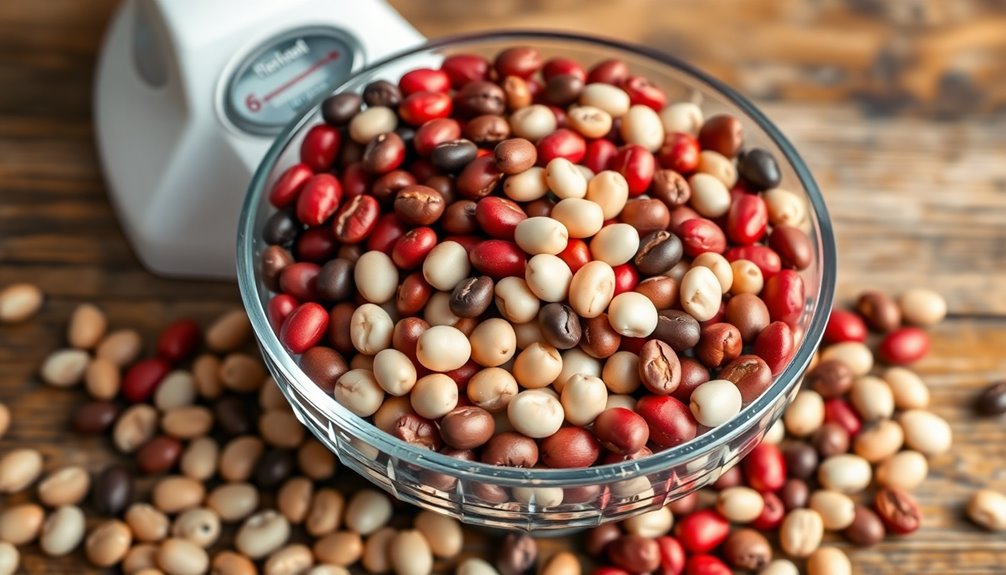
Understanding portion sizes can greatly enhance your meal planning, especially when it comes to beans. When you visualize 6 ounces of cooked beans, think of a large clenched fist. This substantial portion translates to about 1 1/4 cups, which is a bit more than double the standard serving size of 1/2 cup, or 3 ounces.
If you're using canned beans, one can typically holds around 1 3/4 cups. To hit that 6-ounce mark, you'll need a little more than one-third of a can. Beans come in a variety—black beans, kidney beans, and chickpeas all offer similar serving sizes, making it easy to switch things up in your meals.
Keep in mind that a 1/2 cup serving of cooked black beans provides about 8 grams of protein. So, when you consume 6 ounces, you're looking at approximately 24 grams of protein just from beans.
Using these visual cues and understanding serving sizes can help you incorporate beans into your diet effectively, ensuring you receive the protein and nutrition you need while enjoying a variety of flavors.
Visualizing 6 Ounces of Nut Butter

When you think about 6 ounces of nut butter, it helps to visualize it as about 1 1/2 heaping dinner spoons or 12 tablespoons.
This portion can pack a hefty protein punch, but you'll want to measure accurately for portion control.
Let's explore how to make healthy choices with nut butter while keeping an eye on those serving sizes.
Measuring Nut Butter Portions
Measuring out 6 ounces of nut butter can be a bit tricky without the right tools. Since a standard serving size is 2 tablespoons, 6 ounces translates to 12 tablespoons of nut butter. To visualize this, think of about six heaping dinner spoons filled with your favorite nut butter—peanut, almond, or tahini. This amount of nut butter provides healthy fats and protein, perfect for spreading across multiple slices of bread or blending into smoothies. However, keep in mind that 6 ounces can contain around 1,000 to 1,200 calories, depending on the type of nut butter you choose. Additionally, incorporating a balanced budget into your meal planning can help manage your overall calorie intake and nutritional needs. Proper portion control is essential, as stove installation guidelines recommend adhering to specific measurements to ensure safety and efficiency. Including nut butter in a meal can also contribute to low carb high protein breakfast ideas, making it a versatile option for various dietary preferences. Moreover, using a precise method like filter maintenance schedules can help you maintain a healthy balance in your diet by ensuring you don't overconsume any particular food group.
For effective portion control, consider using measuring spoons or a kitchen scale. A kitchen scale is especially helpful for accurately measuring out 6 ounces, ensuring you don't go overboard on calories while still enjoying your favorite nut butter. Furthermore, adding ingredients like chia seeds can provide an extra boost of dietary fiber, enhancing the nutritional profile of your meal.
Visual Comparisons of Servings
Visualizing 6 ounces of nut butter can be surprisingly straightforward once you know what to look for. Understanding the serving size of nut butters can help you gauge portions effectively. Here are some visual cues to help you out:
- Medium-sized grapefruit: About the same size as 6 ounces of nut butter.
- Standard coffee mug: Filled to the brim, this mug holds roughly 6 ounces.
- Small mixing bowl: Halfway full, showcasing the dense, energy-rich nature of nut butters.
- Peanut butter: Approximately 1.5 standard jars, each containing about 16 ounces.
- Almond butter on toast: Enough to generously cover six slices of whole-grain toast.
When you think about the standard serving size of nut butters, which is 2 tablespoons, remember that 6 ounces equals about 12 tablespoons or 1.5 cups.
This makes it easier to visualize how much you're actually consuming. Whether you're spreading peanut butter on toast or using almond butter in a recipe, these size comparisons will guide you in measuring out your servings accurately.
Healthy Nut Butter Choices
Choosing the right nut butter can enhance both flavor and nutrition in your diet. When visualizing 6 ounces of nut butter, think about filling about 3/4 of a standard cup or the size of a medium-sized grapefruit. This amount equates to approximately 12 servings, with a standard serving size being 2 tablespoons.
Among the popular options, almond butter stands out, offering about 7 grams of protein per serving. However, be mindful of the calorie content; 6 ounces can contain around 1,200-1,400 calories, depending on the type of nut butter you choose. Additionally, many nut butters are also rich in healthy fats, which can contribute to heart health when consumed in moderation. Chia seeds, which are rich in omega-3 fatty acids, can be an excellent addition to your diet for supporting heart health. Turmeric's anti-inflammatory properties can also complement the health benefits of nut butters. Engaging in mindfulness practices while eating can enhance your appreciation of the flavors and nutrients present in nut butters.
Since nut butters are rich in healthy fats, practicing portion control is essential to maintain balanced nutrition. Using a measuring spoon can help you avoid exceeding the recommended serving size, ensuring you enjoy the benefits without overindulging. Additionally, being aware of nutritional guidelines can help you make informed choices about your overall diet.
Visual cues can also aid in understanding how much you're consuming. By selecting the right nut butter and being mindful of your portions, you can enjoy both the taste and nutrition it provides, enhancing your overall diet.
Visualizing 6 Ounces of Yogurt
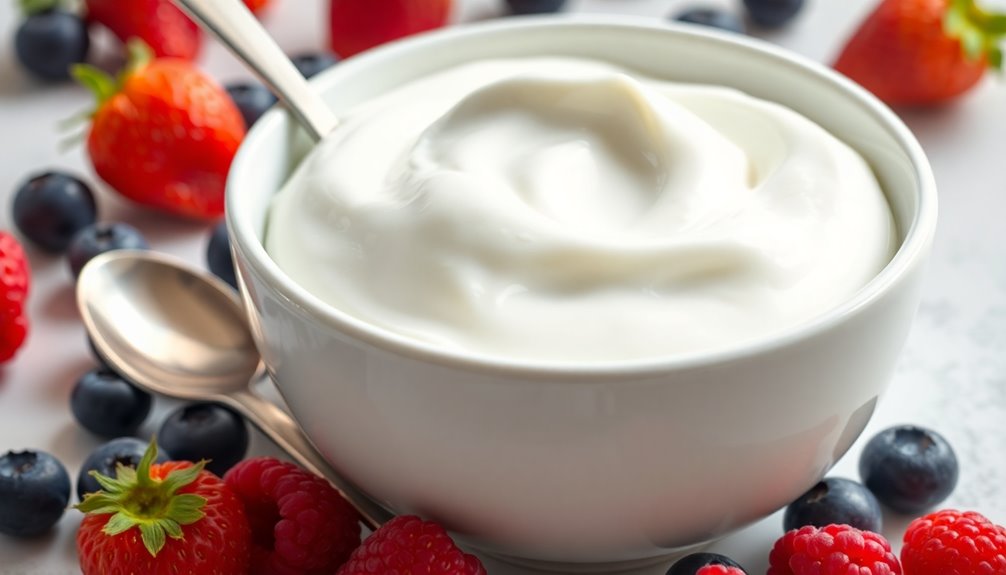
Understanding portion sizes can make healthy eating easier, and when it comes to yogurt, 6 ounces is a manageable serving. Visualizing this amount is key to incorporating it into your diet effectively. Here are some helpful comparisons:
- About three-quarters of a standard cup
- Roughly the volume of a small bowl
- Similar to a standard-sized coffee mug
- Typically found in containers sold at stores
- Provides around 17.25 grams of protein when you're eating Greek yogurt
When you're enjoying 6 ounces of plain yogurt, you're just a bit shy of a full cup, which is usually 8 ounces. This means you can easily measure it out to get the right serving. Additionally, yogurt can be a great source of protein for those following a vegan diet.
A typical serving of Greek yogurt offers a hearty protein boost, making it a great snack or breakfast option. Just remember, whether you're using a small bowl or a coffee mug to visualize, 6 ounces of yogurt can be a delicious and nutritious addition to your meals. Additionally, yogurt can be paired with coffee alternatives to create a balanced and satisfying breakfast.
Keep these visual cues in mind, and you'll find it easier to include yogurt in your healthy eating routine!
Visualizing 6 Ounces of Nuts
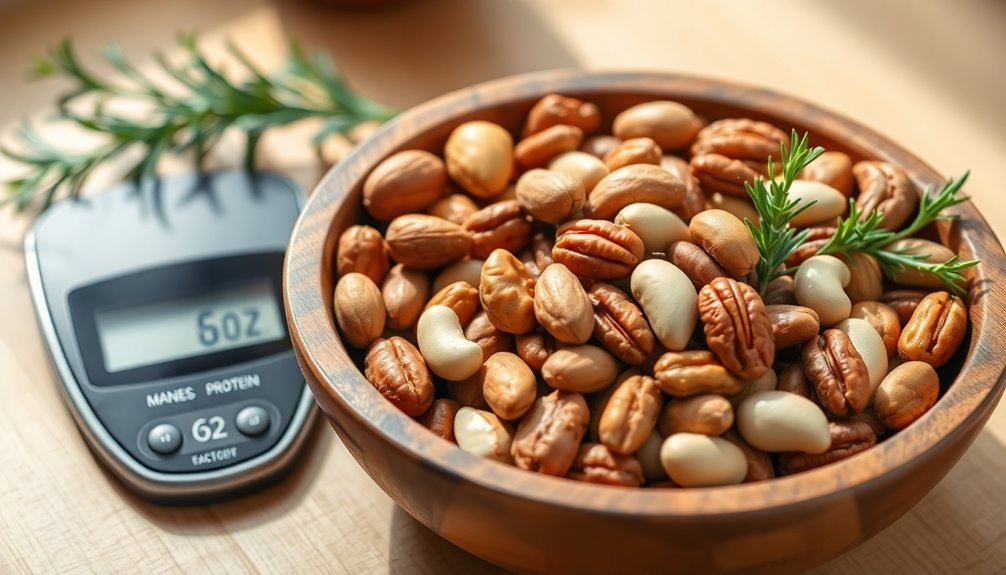
When you think about 6 ounces of nuts, picture a medium-sized bowl brimming with your favorite varieties.
Remember, a standard serving size is 1 ounce, so that means you're looking at about six servings packed with healthy fats and protein.
Whether it's 138 almonds or 294 pistachios, visualizing these amounts can help you understand how much you're really eating. Additionally, incorporating herbal teas into your diet can complement your healthy snacking habits with their various health benefits.
Nut Serving Sizes
Visualizing 6 ounces of nuts can be made easier by thinking of it as a medium bowl brimming with your favorite varieties. A standard serving size of nuts is just 1 ounce, which means you're looking at about six servings when you fill that bowl.
Here are some helpful visual cues to keep in mind:
- 23 almonds per ounce
- 7 walnut halves per ounce
- 49 pistachios per ounce
- About 6 small handfuls
- 6 small bags of pre-portioned nuts
When you consume 6 ounces, you're getting around 36-42 grams of protein, depending on the nut type. Nuts are calorie-dense, totaling approximately 1,000 to 1,200 calories in 6 ounces.
As a result, practicing portion control is essential when incorporating them into your diet. To help with this, try stacking your nuts in a clear container; it holds about 1.5 to 2 cups, which visually represents that 6-ounce serving.
Visual Comparisons for Nuts
You'll often find that visual comparisons can make it easier to grasp what 6 ounces of nuts looks like. Since a standard serving size of nuts is 1 ounce, this means you're looking at about 6 servings. Imagine this: 6 ounces could fill a small bowl or container, roughly equating to a generous handful of nuts.
To get specific, you might visualize around 138 almonds, 42 walnut halves, 510 pumpkin seeds, or 294 shelled pistachios. These visual cues help you understand the volume involved. Remember, nuts are calorie-dense, so 6 ounces can pack in about 1,200 to 1,500 calories, depending on the type. That's why portion control is crucial!
To enjoy a variety of tastes and textures, consider mixing different nuts. This way, you can savor diverse flavors while still hitting that protein-rich target. Incorporating various nuts also guarantees you're benefiting from healthy nutrients.
Frequently Asked Questions
What Does 1 Ounce of Protein Look Like?
When you think about 1 ounce of protein, visualize a small handful of nuts, like about 23 almonds or 7 walnuts.
If it's meat, it's roughly the size of a small matchbook. For cheese, picture a pair of dice, while for fish, think of a small piece of sushi.
Finally, a quarter cup of cooked beans, like black beans, rounds out your protein options nicely. This helps you gauge your portions effectively.
How to Measure 6 Oz of Meat?
Did you know that the average American eats about 200 pounds of meat each year?
To measure 6 ounces of meat, you can use a kitchen scale for precision. If you don't have one, visualize it as two stacked decks of playing cards or the size of two palms.
For ground meat, think of a medium apple.
These comparisons help you gauge the right portion without needing a scale every time.
Is 6 Ounces of Protein a Day Enough?
You're likely wondering if 6 ounces of protein a day is enough for you.
For many adults, it can provide a significant portion of your daily protein needs, especially if you're active or aiming to maintain muscle mass.
However, individual requirements vary based on age, activity level, and health goals.
It's crucial to assess your specific needs and guarantee you balance protein with other nutrients for a well-rounded diet.
What Is an Example of 6 Grams of Protein?
If you're looking for examples of 6 grams of protein, consider a large egg, which packs about 6 grams.
You could also enjoy two tablespoons of peanut butter, slightly exceeding your target at around 7 grams.
Alternatively, a 1-ounce serving of shredded cheese gives you just over 7 grams.
If you prefer plant-based options, half a cup of cooked black beans provides around 8 grams, easily meeting your protein needs.
Conclusion
Now that you've got a clear idea of what 6 ounces of various protein sources look like, you can easily incorporate them into your meals. For instance, imagine prepping a delicious stir-fry with 6 ounces of chicken, paired with colorful veggies and brown rice. This balanced meal not only meets your protein needs but also keeps your plate vibrant and nutritious. Remember, visualizing portions can make a big difference in achieving your dietary goals!
